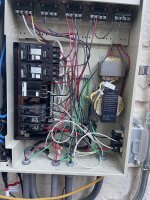- Jul 12, 2021
- 86
- Pool Size
- 15000
- Surface
- Plaster
- Chlorine
- Salt Water Generator
- SWG Type
- Pentair Intellichlor IC-40
I am looking to protect my Intellicenter, and have read the post here on the topic. I have some specific questions I'm hoping to get help with...
Background:

Background:
- I have an Intellicenter load center with 100 amps running to it, connected via ethernet.
- I want to add surge protection for this sub panel to protect the Intellicenter.
- I have a single pole opening left after the following, which draw 55.5a total:
- Intelliflo VS pump (pool) 16a
- Raypak 406a propane heater 4a
- Hayward Northstar pump (waterfall) 15a
- Volt 300W LED transformer (landscape lights) 2.5a
- Pentair lights (2x SAM, 1 x Amerlite) 15a
- Intellicenter (inc. SWG) 3a
- A surge protector for a subpanel. The HEPD80 is mentioned a lot: https://www.amazon.com/Square-Schneider-Electric-HEPD80-Electronics/dp/B00CONA1OQ
- A surge protector for the ethernet line to the house. The one mentioned in the article is not available anymore. This seems similar: https://www.amazon.com/CERRXIAN-Ethernet-Protector-Protection-Suppressor/dp/B07K4YXQVR/
- I understand that there are varying levels of protection, but not how the surge protector should be sized for my use. Is the 80 kA protection from the HEPD80 sufficient? Are there better options?
- Is the ethernet surge protector a good choice to protect the panel from the electronics in the house it connects to (patch panel to 48 spot switch)?
- I understand that the surge protector needs to run to 2x 20a breakers. Given that I have a single 1-pole spot left, can I use a double 20a breaker in a single pole config like this: Siemens (2) 20 Amp Tandem Single Pole Type QT NCL-Circuit Breaker Q2020NCU - The Home Depot






